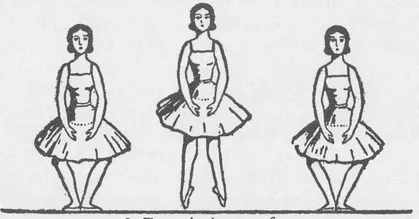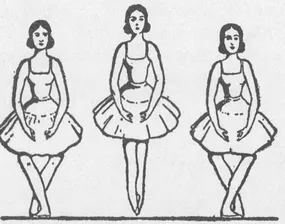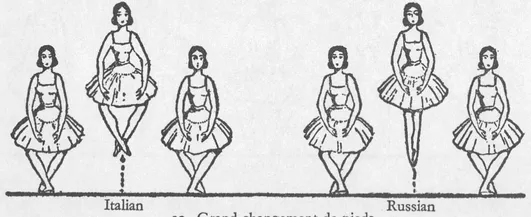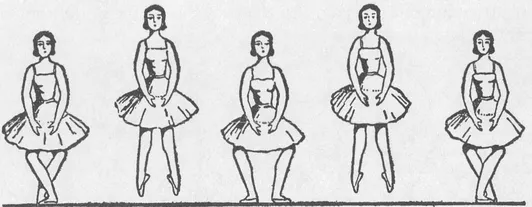![]()
VII
JUMPS
JUMPS IN classical ballet are highly diversified. In further study we will see that they are divided into two basic groups.
In the first group are the aerial jumps. For these jumps the dancer must impart a great force to the movement, must stop in the air.
In the second group are the movements which, without a literal jump, cannot be made without tearing oneself away from the ground. These movements, however, are not directed up into the air; they are done close to the ground.
Jumps which are not directed into the air but are parallel to the floor include: pas glissade, pas de basque, and jeté en tournant (in the execution of the first part of this movement).
Aerial jumps are divided into four kinds:
1. Jumps from both feet to both feet which are subdivided into: (a) those done directly from 5th position, as changement de pieds, échappé, soubresaut; (b) done with a movement of one foot from 5th position to the side, as assemblé, sissonne fermée, sissonne fondue, sissonne tombée, pas de chat, failli, chassé, cabriole fermée, jeté fermé fondu.
2. Jumps from both feet to one foot, which have the following subdivisions: (a) when at the beginning the dancer tears himself away from the floor with both feet and finishes the movement on one foot (in a pose), as sissonne ouverte, sissonne soubresaut, ballonné, ballotté, rond de jambe en l’air saute; (b) when the movement begins with a thrusting out of the leg (a take off) and ends with a stop on the same foot in a pose, as jeté from 5th position, grand jeté from 5th position, jeté with a movement in a half-turn, emboité.
3. Jumps from one foot to the other, as jeté entrelacé, saut de basque, jeté passé, jeté in attitude (when it is done from a preparation in 4th position croisé).
4. Combination jumps, the structure of which embodies several elements, as jeté renversé, sissonne renversée, grand pas de basque, double rond de jambe, pas ciseaux, balancé, jeté en tournant and grand fouetté.
Aerial jumps can be small and big, but no matter what their form, the action of leaving the floor must always be clearly visible.
In the development of the jump the following instructions should be followed:
1. Every jump begins with demi-plié. Since the main factor in imparting force at the moment of leaving the floor is the heel, it is necessary, at the development of the jump, to pay special attention to the correctness of demi-plié, i.e. one must see to it that the heels are not lifted from the floor in demi-plié.
2. If the jump is done on both legs, the legs must be forcefully extended in the knees, arches and toes at the moment of the jump. If the jump is done on one leg, the other assumes the position required by the pose. In this case the upper part of the leg must be fully turned out, the back must be straight, the buttocks should not protrude.
3. After the jump the feet must touch the floor first with the toe, then softly with the heel, then lowered into demi-plié. After this the knees should be straightened.
Elevation consists of two elements: elevation proper and ballon.
Elevation in the proper sense of the word is a flight. A man leaves the ground and does a high jump in the air. But such a jump can be meaningless, just an acrobatic feat. A circus acrobat can jump over ten people in a row. His dexterity will amaze us, but we cannot consider that he has elevation. It is a mechanical trick, made possible by well-trained muscles. In dance elevation, ballon must be added to the jump.
Under the term ballon, we understand the ability of a dancer to hold in the air a pose or position, which is customary for him on the ground. The dancer stops in the air, remains there as if suspended. Consequently, when we speak of classic elevation we deal with high jumps connected with ballon.
Elevation is developed through a number of movements. For the development of the jump ending on both feet, we use changement de pieds; for the development of the jump ending on one foot with a movement forward, back and to the side—“the springboard type”—we use pas ballonné. These preparatory steps for high elevation must be done with great perseverance and attention and in great numbers.
The study of jumps is approached gradually. For children and beginners the following serves as the initial exercise:
Stand in 1st position, demi-plié, push off with the heels, and jump, extending the toes and arching the feet. Coming down, touch the floor with the toes and, in the next moment, lower yourself on the heels into demi-plié, and then straighten the knees.
48. Temps levé on two feet
The same thing is done from the 2nd and 5th positions. These jumps are called temps levé. Subsequently, during the study of temps levé in the middle of the floor, it is often done on one foot, i.e. one foot does the jump, the other keeps the position taken before the jump. After this we turn to changement de pieds.
CHANGEMENT DE PIEDS
PETIT CHANGEMENT DE PIEDS
Stand in 5th position, right foot front, demi-plié, push off from the floor, jump up, extending the toes and arching the feet. Coming down, change the feet, left foot will then be front. Come down as in temps levé: first the toes then heels, finishing the movement in demi-plié in 5th position.
49. Petit changement de pieds
This method develops softness and elasticity of the jump, ridding it of its hardness.
For more advanced pupils I prefer a different variation of petit changement de pieds. Everything is done as before, but the jump does not tear the feet away from the floor. The toes are touching the floor all the time, as if you were only rising on your toes. The movement is done in an uninterrupted series, without any pause on the plié, although it must be said that the accent is made not into the air, but into the floor, on the plié.
In this manner the exercise is still more energetic and effective in its results.
It is used at the conclusion of exercises in the centre (after allegro) in a fast tempo.
GRAND CHANGEMENT DE PIEDS
For this exercise demi-plié is done deeper and with greater effort in order to rise higher. Push off forcefully from the floor with the heels, bring the legs together and hold them this way until the very last moment and only then change them. Lower yourself in the same way as in petit changement de pieds.
The bigger the jump, the deeper should be the demi-plié before it. Attention must be paid that the heel, due to the strain, should not be lifted from the floor.
50. Grand changement de pieds
When changing the legs in the air do not move them far apart. If you do that, you will lose the form of changement de pieds, because this step is a change of feet in the 5th position. The legs should be moved apart only as much as is needed for the transfer, no more.
At the beginning of the study of jumps, attention must be paid to the arms, which must remain absolutely relaxed from the shoulders to the hands, slightly curved, as in the preparatory position; they must not jerk as if trying to help the movement of the legs.
In the Italian school it is customary to bend the knees when doing changement de pieds.
PAS ÉCHAPPÉ
PETIT ÉCHAPPÉ
Demi-plié in 5th position, push off with the heels, and immediately, with extended toes and straightened knees, jump into 2nd position in demi-plié, adhering strictly to the directions given for plié in 2nd position. Return with the same kind of a jump, with extended toes and straightened knees, finishing in 5th position.
This pas can also be done in 4th position croisé and effacé, giving the arms an appropriate pose. In general, however, during small jumps the poses of the arms should not be high. The high positions of the arms should be left for big jumps.
In doing échappé one must watch that the plié on both feet is even; special attention to this must be paid when doing échappé in 4th position.
Échappé can be done with a finish on one foot. The entire pas is the same as above, only the finish is different. The feet do not return into 5th position, but one of them goes sur le cou-de-pied front or back. This échappé is done in 4th position as well as 2nd.
GRAND ÉCHAPPÉ
In petit échappé, in the jump, the legs open immediately in 2nd position. In grand échappé extend the legs, after a deep demi-plié, in a closed 5th position during the highest possible jump, and only coming down, open them into 2nd pos...




